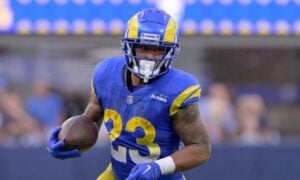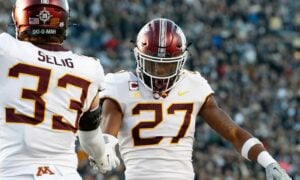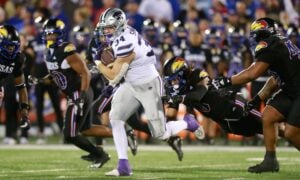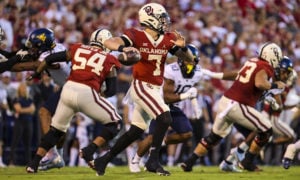When Losing the Trade Battle is a Good Thing

As the offseason and your quest to improve your roster continues, you don’t need me to tell you it’s going to be very hard to make any real improvements to your roster without a few trades. I get asked many times on Twitter if I like a certain trade. I always let folks know there are two ways to grade these trades. One, you can grade it player vs. player in a vacuum, meaning just based on value. Two, you grade it in the context of your overall roster, which is my preferred method. Obviously that’s tough to do on Twitter.
I approach trades as business transactions. That means I look at it in terms of supply and demand, sale price or retail price. Each transaction is different because in one league a player may be for sale because an owner is looking to rebuild their roster. In another league, the same player may be on a roster that requires you to pay retail price or even higher to acquire him.
Let’s look at the approach from paying the retail price. In cases where improving your roster is the ultimate goal (which we tend to forget this goal at times) my strategy is to pay what needs to be paid to put my roster in the best shape to compete. Do I care if someone who has no knowledge of my roster or my strategy thinks I overpaid for a player? No. What I care about is did this trade make my roster better in my eyes. If the answer is yes, does it really matter if I had throw in an extra draft pick or player into the pot to get the deal done? Again, the answer is no.
Sometimes you really have to “make an offer they can’t refuse” to pull off a trade – that can get expensive real fast. However, sometimes it’s a necessary measure to take to your team to another level of competition.
Too often we get hung up on the term “value.” Value is good, but if the ultimate goal is to win championships, “value” needs to be strategically put aside from time to time to win.
This very subject came up in a recent trade I made. My trade target? Drew Brees. Yes, the same Drew Brees who was the overall leader in fantasy points last season. After assessing my team, I viewed it to be a star quarterback short of competing for the championship. Owners of star quarterbacks don’t usually give them away. In fact, you’ll likely have to overpay pretty drastically to close the deal. You have to come strong or get laughed at.
Let’s back up a bit and let me explain how I got here. When I took over this particular roster a year ago, I had two legitimate starters on the roster heading into the season last year – I had Matt Forte and the draft rights to Julio Jones (24 man, 12 team PPR league with six points for all touchdowns, including quarterbacks). My strategy was to turn those two players into as many valuable pieces as I could. I needed to acquire a combination of players and draft picks and I couldn’t afford to miss on those draft picks for this plan to work. To give you a clear understanding of the mess I inherited, here is the “before” picture:
QB: Chad Henne, Kevin Kolb, Donavan McNabb, Tim Tebow
RB: Marion Barber, Matt Forte, Brandon Jacobs, Laurence Maroney, Knowshon Moreno, Dimitri Nance, Steve Slaton
WR: Davone Bess, Deon Butler, Lee Evans, Brain Hartline, Mohamed Massaquoi, Josh Morgan, Santana Moss, Kevin Walter, draft rights to Julio Jones
TE: Kevin Boss, Zach Miller (I’m leaving out defense and kicker because they don’t matter for this discussion)
Now you see the cards that I was dealt (to be perfectly honest, these are the only type of teams I like to take over since I love nothing more than a crappy roster to fix). In my first year as the owner of this team, I made calculated trade after trade with the ultimate goal to position my team to be able to make a big trade or two to position my team for competition within one year or two, tops. If I didn’t turn the team into a contender within that time frame I consider it a failure.
Between the time frame of April and October of last season, I completed eight trades to fully turnover my roster. By the time I was done with the first full year of owning the team, I felt I’d acquired enough draft pieces and players to position myself to compete for a playoff spot. Many of those trades I consider myself to be on the winning side. A select few of them, however, I took losses on.
That brings me back to the big trade – the expensive acquisition of Drew Brees.
This is a deal I will admit to overpaying on. I gave up Andrew Luck, Roy Helu, Leonard Hankerson, 2012 1.10 AND a developmental pick (rights to an NCAA draft eligible player) at 1.4 for Drew Brees, LeGarrette Blount, James Jones, and this year’s 1.5.
Like I said, I had to overpay or the deal was dead before it ever got started. Now, if you were to grade this trade in a vacuum, I’d say the guy really got over on me. However, if you look at it in terms of what it did to raise my competitive chances and factor in what this roster used to be, I consider it a calculated loss I’d do 100 times over again.
I laid out what my roster looked like “before.” Now take a look at it “after” picture. Also keep in mind this was done in the span of just one calendar year.
QB: Drew Brees, Jay Cutler, Carson Plamer, Matt Cassel
RB: Steven Jackson, James Starks, Lamar Miller, LeGarrette Blount
WR: Victor Cruz, Jordy Nelson, Brandon LeFell, Davone Bess, Kendall Wright, James Jones, Marvin Jones, AJ Jenkins, Josh Morgan, Randy Moss, David Nelson, Devon Wylie
TE: Fred Davis, Mercedes Lewis
This may not be the best team in the league, but it now has enough firepower to be taken seriously. If I were to tell you at the start of this rebuild I could turn the “before” roster into the “after” roster, would you take it? My answer is, of course, yes. Not only did I acquire enough trade pieces to give up for a superstar quarterback, I also managed to have a very competitive roster after the fact.
It is possible to turn around a hopeless roster into a contending one in one year. If you use sound trade strategy and draft well, you can do it. You shouldn’t get bogged down in the “value” conversation all the time. We play dynasty football because we are competitors and want to win championships. Sometimes we turn away trade opportunities that actually improve our rosters because it isn’t a good “value” deal or for fear of your league mates making fun of you on the message boards.
No one knows your team and your endgame better than you do. Be bold and be willing to take the “value” hit on some trades. If it puts you in a better position to fight for that league crown pull the trigger. Never lose sight of the big picture – the goal is to win championships.
They don’t give out trophies for trades.
Follow Paymon on Twitter – @SetMyRoster

































































